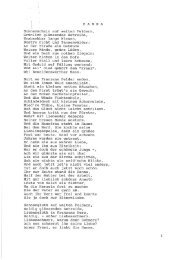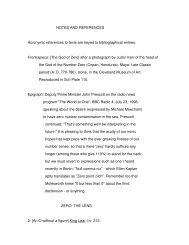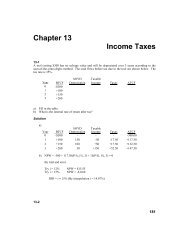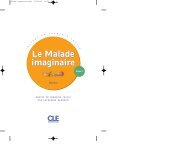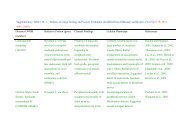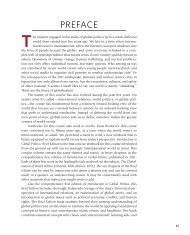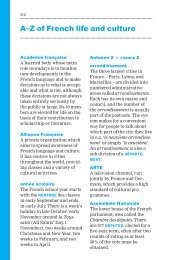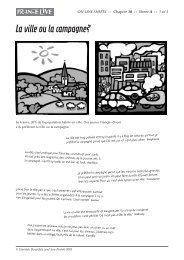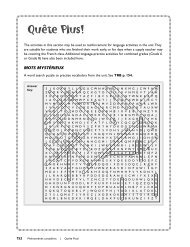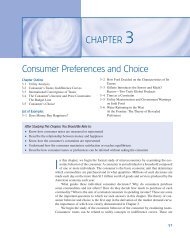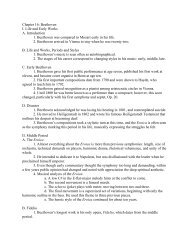Figure 1
Figure 1
Figure 1
Create successful ePaper yourself
Turn your PDF publications into a flip-book with our unique Google optimized e-Paper software.
SUPPLEMENTARY MATERIALS<br />
NOTE: ANY HANDOUT MAY ALSO BE COPIED AND USED AS AN<br />
OVERHEAD. TEACHERS WHO DOWNLOAD THE MANUAL MAY PROJECT<br />
MATERIALS USING A LCD PROJECTOR.<br />
Sambaenredo<br />
Samba de<br />
morro<br />
Sambacanção<br />
Pagode<br />
Sambade-roda<br />
Origins Purpose<br />
/Function<br />
CHAPTER 1<br />
Brazil’s National Music<br />
HANDOUT 1.1<br />
Chapter 1 Style/Genre Reference Guide<br />
Description/Characteristics
HANDOUT 1.2<br />
Song Comparison Chart<br />
Song/Artist Tempo Instruments/Voice Form Description<br />
39
Choro<br />
Brazilian<br />
Art Music<br />
Bossa<br />
Nova<br />
Tropicália<br />
MPB<br />
Música<br />
Brega<br />
CHAPTER 2<br />
Projecting Brazilian Identity Nationally and Internationally<br />
Origins Purpose<br />
/Function<br />
HANDOUT 2.1<br />
Chapter 2 Style/Genre Reference Guide<br />
Description/Characteristics<br />
40
HANDOUT 2.2<br />
"Língua de Preto” Listening guide<br />
Timing Event Description<br />
0:00 Theme 1<br />
0:46 Theme 2<br />
1:01 Theme 1<br />
1:22 Theme 3<br />
1:42 Repeat and transition<br />
1:59 Theme 1<br />
2:24 Coda<br />
2:50 Fade out<br />
41
HANDOUT 2.3<br />
“The Girl from Ipanema” (“"Garôta de Ipanema")<br />
Time Event Melody Description<br />
0:00 Intro Male vocal<br />
João Gilberto<br />
0:08 A Male vocal<br />
0:23 A Male vocal<br />
0:37 B Male vocal<br />
1:07 A Male vocal<br />
1:22 A Female vocal<br />
Astrud Gilberto<br />
1:36 A Female vocal<br />
1:51 B Female vocal<br />
2:21 A Female vocal<br />
2:35 AABA Saxophone solo<br />
Stan Getz<br />
3:38 A Piano<br />
Tom Jobim<br />
3:52 A Piano<br />
4:18 B Female vocal<br />
4:48 A Female vocal, Saxophone<br />
counterline<br />
5:00 Coda Female vocal, saxophone<br />
fills<br />
43
Roberto<br />
Carlos:<br />
King of<br />
Brazilian Pop<br />
Music<br />
Length of From 1958 to<br />
career present<br />
Record sales Total of more<br />
than 100<br />
million copies;<br />
first Latin<br />
American to<br />
sell more than<br />
Entertainment<br />
media<br />
Covers by<br />
other artists<br />
the Beatles<br />
Recordings;<br />
Live concerts;<br />
Radio;<br />
Television;<br />
motion pictures<br />
Songs recorded<br />
by other major<br />
Brazilian<br />
artists<br />
HANDOUT 2.4<br />
Comparison of Artists<br />
Benny<br />
Goodman:<br />
King of Swing<br />
Clifton<br />
Chenier:<br />
King of Zydeco<br />
Elvis Presley:<br />
The King of<br />
Rock and Roll<br />
44
Capoeira<br />
Angola<br />
Capoeira<br />
Regional<br />
Capoeira<br />
Atual<br />
Music of<br />
the<br />
Kayapó-<br />
Kikrin<br />
CHAPTER 3<br />
Expressing Afro-Brazilian and Indigenous Identity<br />
HANDOUT 3.1<br />
Chapter 3 Style/Genre Reference Guide<br />
Origins Purpose/Function Description/Characteristics<br />
46
Handout 3.2<br />
Angola Toque<br />
Handout/Overhead 33<br />
Berimbau Comparisons<br />
Instrument Pitch range Function<br />
Berimbau gunga Low Plays the principal rhythm pattern<br />
called the toque<br />
Berimbau médio Middle Plays a rhythm that complements<br />
that of the berimbau gunga<br />
Berimbau viola High Plays variations and decorations<br />
of the basic rhythm<br />
47
Bumbameu-boi<br />
Cavalo-<br />
Marinho<br />
Maracatu<br />
de Nação<br />
Maracatu<br />
Rural<br />
Baião<br />
Forró<br />
Origins Purpose<br />
/Function<br />
CHAPTER 4<br />
The Sound of the Northeast<br />
HANDOUT 4.1<br />
Chapter 4 Style/Genre Reference Guide<br />
Description/Characteristics<br />
48
Rabeca baiano, 1<br />
Rabeca baiano, 2<br />
HANDOUT 4.2<br />
50
HANDOUT 4.3<br />
"Forró em Monteiro" Listening Guide<br />
CD Track 13 CD Track 14<br />
Instrumentation Solo sanfona de oito baixos sanfona de oito baixos, triangle,<br />
(Button accordion)<br />
pandeiro, zabumba<br />
Start of transcribed melody 0:04 0:08<br />
Tempo Quarter = 192+ Varies<br />
Description/Comments on<br />
performance of first half of<br />
melody.<br />
Timing of repeat of first melody 0:12 0:17<br />
Note any differences during<br />
repeat of first half of melody.<br />
Timing of start of second half of<br />
melody<br />
Description/comments on<br />
performance of second half of<br />
melody<br />
Timing of repeat of second half<br />
of melody<br />
Note any difference during repeat<br />
of second half of melody<br />
0:20 0:25<br />
0:29 0:34<br />
D.S. to beginning 0:37 0:42<br />
Repeat on D.S 0:44 0:51<br />
Played an octave lower<br />
51<br />
Both 1 st and 2 nd part are repeated<br />
again before fading out
OVERHEAD 4.4<br />
"Forró em Monteiro “ Melody<br />
52
Música<br />
caipira<br />
Música<br />
sertaneja<br />
Música<br />
gaúcha<br />
Origins Purpose<br />
/Function<br />
Toadas<br />
Modas-de-viola<br />
CHAPTER 5<br />
Expressing Southern Brazilian Identity<br />
HANDOUT 5.1<br />
Chapter 5 Style/Genre Reference Guide<br />
HANDOUT 5.2<br />
Description/Characteristics<br />
Comparison of Toadas and Modas-de-viola<br />
53
HANDOUT 5.3<br />
“Queluzindo” Listening Guide<br />
Timing Event Description<br />
0:00 Theme A<br />
0:27 Fingers on wood<br />
0:39 Pause<br />
0:41 Theme B<br />
1:00 Repeat<br />
1:23 Theme ?<br />
2:00 Pause<br />
2:02 Theme ?<br />
2:31 Pause<br />
2:32 Theme ?<br />
3:15 Final chord<br />
HANDOUT 5.4<br />
Música Sertaneja Style Comparison Chart<br />
Sub-style Description/Characteristics<br />
Acoustic sertaneja<br />
“Modernized”<br />
sertaneja<br />
Today’s Sertaneja<br />
54
Eu quero andar nas coxilhas<br />
Sentindo as flechilhas das ervas do chão<br />
Ter os pés roseteados de campo<br />
Ficar mais trigueiro com o sol de verão<br />
Fazer versos, cantando as belezas<br />
Desta natureza sem par<br />
E mostrar, para quem quiser ver<br />
Um lugar pra viver sem chorar.<br />
É o meu Rio Grande do Sul<br />
Céu, sol, sul, terra e cor<br />
Onde tudo que se planta cresce<br />
E o que mais floresce é o amor.<br />
Eu quero banhar nas fontes<br />
E olhar horizontes com Deus<br />
E sentir que as cantigas nativas<br />
Continuam vivas para os filhos meus.<br />
HANDOUT 5.5<br />
"Céu, Sol, Sul, Terra e Cor" Lyrics<br />
Portuguese English<br />
Ver os campos florindo e crianças sorrindo<br />
Felizes a cantar<br />
E mostrar, para quem quiser ver<br />
Um lugar pra viver sem chorar.<br />
I want to walk on the grasslands<br />
Feeling the grass on the ground<br />
To have my feet roughened from walking in the<br />
country<br />
Become browned by the summer sun<br />
To write poetry that sings of the beauties<br />
Of this unequaled nature<br />
And show to whomever wants to see<br />
A place to live without sadness<br />
It's my Rio Grande do Sul<br />
Sky, sun, south, land, and color<br />
Where everything planted grows<br />
And what flourishes most is love<br />
I want to bathe in the springs<br />
And see horizons with God<br />
And feel that the native songs<br />
Will be alive for my sons<br />
To see the fields flowering and children smiling<br />
Singing happily<br />
And show to whomever wants to see<br />
A place to live without sadness<br />
55
HANDOUT 5.6<br />
"Céu, Sol, Sul, Terra e Cor" Listening Guide<br />
Timing Event Description<br />
0:00 Introduction Triple meter, viola, bass, percussion<br />
0:17 Verse Solo male voice<br />
0:46 Male and female voices-- 3 rd /6ths<br />
0:55 Verse Solo male voice<br />
1:09 Male and female voices—3rds/6ths<br />
1:34 Verse Solo male voice<br />
2:02 Male and female voices—3rds/6ths<br />
2:12 Verse Solo male voice<br />
2:25 Male and female voices—3rds/6ths<br />
2:50 Ending Fade out with accordion<br />
56
HANDOUT 5.7<br />
“Milonga Para as Missões” Listening Guide<br />
Timing Event Description<br />
0:00 Introduction Improvisatory style with guitar, button accordion; arpeggios,<br />
chords, brief motifs<br />
0:36 Measure 1 of<br />
transcription<br />
As notated; measure two is more extended on recording<br />
0:43 A Percussion accompaniment added<br />
0:59 B<br />
1:13 Post-B<br />
1:21 A Adds brass background at 1:26<br />
1:35 B<br />
1:49 Post-B Interlude is extended<br />
1:59 A Much different from notation—mostly brass section lead<br />
2:15 B<br />
2:29 Post-B Brass lead beginning at 2:35<br />
2:43 A Return to less complex-more like section at 1:21<br />
2:57 B<br />
3:13 Post-B Very abbreviated-ends with chord and fall in brass<br />
58
Mangue<br />
Origins Purpose<br />
/Function<br />
CHAPTER 6<br />
Innovative Music Scene of Recife<br />
Handout 6.1<br />
Chapter 6 Style/Genre Reference Chart<br />
Description/Characteristics<br />
59
É um vaquero encourado<br />
Dois touro brabo correndo<br />
Tres contavento moedo<br />
Quatro cego malcriado<br />
Cinco duzia de aleijado<br />
Sies velha pedindo esmola<br />
Cinco duzia de aleijado<br />
Sies velha pedindo esmola<br />
Sete pásso na gaila<br />
Oito carga de aguardente<br />
Nove elha sem ter dente<br />
Dez cordas numa viola<br />
Com dez eu pego na casa<br />
Com vinte assento os esteio<br />
Com trinta eu parto o meio<br />
Quarenta eu nao me atraso<br />
Com cinquenta eu cavo a base<br />
Sessenta a porta e a janela<br />
Setenta eu obro a tigela<br />
Oitenta eu ripo e amarro<br />
Com noventa eu bato o barro<br />
E com cem estou dentro dela<br />
Lá na Torre Malakoff<br />
Vi acender uma luz<br />
Na rua do Bom Jesus<br />
Afinei minha rebeca<br />
Fui para a Rua da Moeda<br />
Tocar com muita armonía<br />
Fui para a Rua da Moeda<br />
Tocar com muita armonía<br />
Lá tem gente todo dia<br />
Vai até de madruga<br />
Tomando muita cachaca<br />
No Bar da Cachacaria<br />
HANDOUT 6.2<br />
“Samba de Dez Linhas” Lyrics<br />
It’s one leather clad cowboy<br />
Two wild bulls running<br />
Three wind-powered mills grinding<br />
Four rude blind men<br />
Five dozen cripples<br />
Six old ladies begging<br />
Five dozen cripples<br />
Six old ladies begging<br />
Seven birds in the cage<br />
Eight shots of cane rum<br />
Nine toothless old ladies<br />
Ten Strings on a viola.<br />
With ten I start the house<br />
With twenty I set the supports<br />
With thirty I divide it in the middle<br />
Forty I don’t delay<br />
With fifty I dig the foundation<br />
Sixty the door and window<br />
Seventy, I raise the walls<br />
Eighty I raise the roof beam and tie the tiles<br />
With ninety I line it with clay<br />
And with a hundred I’m inside it<br />
There in Malakoff tower<br />
I saw a light go on<br />
On the Rua do Bom Jesus<br />
I tuned my rebeca<br />
I went to the Rua da Moeda<br />
To play with much harmony<br />
I went to the Rua da Moeda<br />
To play with much harmony<br />
It’s crowded there every day<br />
Until dawn<br />
Drinking lots of cachaca<br />
At the Cachacaria Bar.<br />
60
HANDOUT 6.2<br />
“Samba de Dez Linhas” LISTENING GUIDE<br />
Time Event Description<br />
0:00 Introduction<br />
1:04 Solo<br />
1:18 Chorus<br />
1:23 Solo voice<br />
1:39 Instrumental section<br />
2:12 Solo<br />
2:27 Chorus<br />
2:32 Solo<br />
Instrumental<br />
solo<br />
Chorus<br />
Solo<br />
Instrumental<br />
Coda Techno pop, electronic<br />
61
Handout 6.3<br />
“Samba de Dez Linhas” Instrumental Motifs<br />
62



